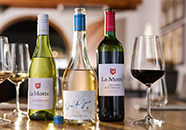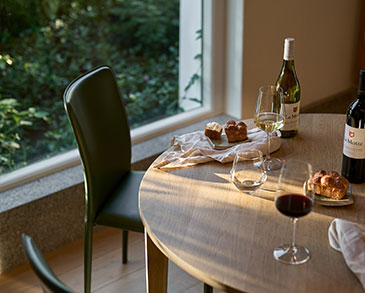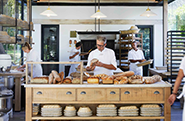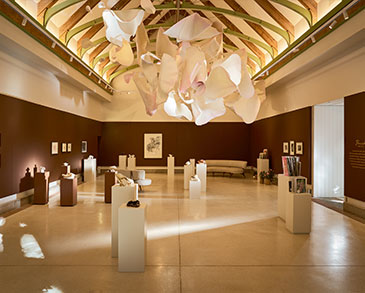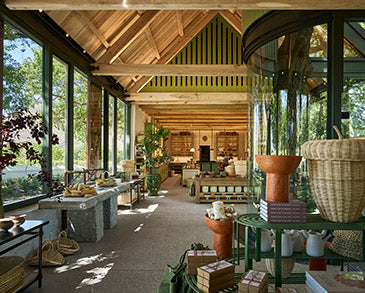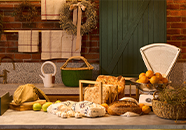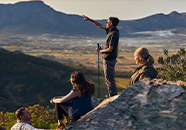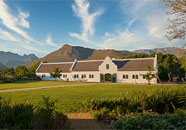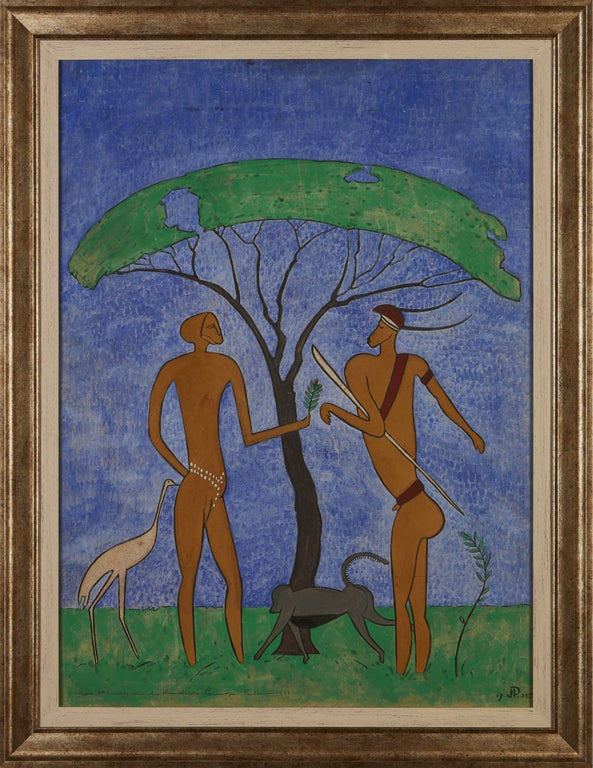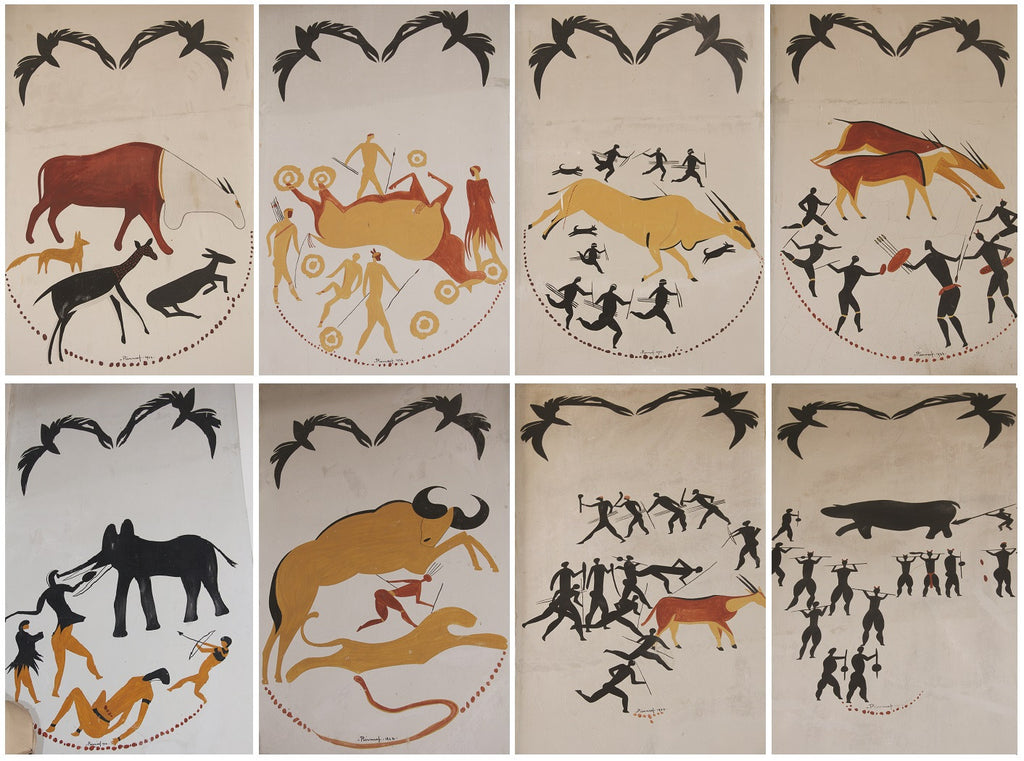Pierneef en San rotskuns / Pierneef and San rock art
Wanneer ’n mens na J H Pierneef se Adam en Eva (1925) kyk en dit tussen sy ander werke probeer plaas, kan jy dalk wonder waar en óf dit enigsins inpas. As biblioteekassistent by die Staatsbiblioteek het Pierneef waarskynlik tot verskeie bronne en die jongste publikasies oor prehistoriese kuns toegang gehad, wat straks sy belangstelling geprikkel het. Dit het, onder meer, The Eldorado of the Ancients deur Carl Peters (1902), Native Races of South Africa deur George Stow (1905) en Bushman Paintings deur Helen Tongue (1909) ingesluit.
Pierneef het eers in April 1937 op die plaas Ebenhaezer naby Fouriesburg direkte tekeninge vanaf rotskuns gemaak. Wat hy dus in die vroeë jare 1900 in bogenoemde publikasies waargeneem het, het hy as akkurate weergawes van San-rotskuns beskou. Latere navorsing oor bogenoemde natrektekenaars van San-rotskuns bewys egter dat hierdie tekenaars tóé reeds aan die oorspronklike verander het deur met komposisie te speel. Enkeltekeninge wat as ’n eenheid aangebied is, is in der waarheid uit sketse van verskeie terreine saamgestel.
Die verbintenis tussen Pierneef en tydgenoot Erich Mayer kan tot 1913 teruggevoer word. Albei het ’n lewendige belangstelling in San-rotskuns gehad. Deur sy verbintenis met Mayer het Pierneef in 1916 toegang tot die oorspronklike tekeninge deur George W Stow in Dorothea Bleek se besit verkry.
Met die lewer van sy eerste lesing oor inheemse kuns voor lede van Onze Taal in Bloemfontein, in 1917, het Pierneef met Reenen J van Reenen bevriend geraak. Pierneef het sy eerste groot openbare opdragwerk in 1922 deur Van Reenen ontvang— om die nuwe skoolsaal van Hoërskool Ficksburg (deesdae die SH Pellissier-galery) met motiewe van San-rotskuns te versier. Daar was altesaam agt panele van 1,2 m x 2,9 m elk en ’n fries teen die plafon reg rondom die saal. Pierneef het op Stow, Tongue en Van Reenen se tekeninge as ‘hoofbronne’ staatgemaak. Elke paneel is dus ’n komposisie van verskeie tekeninge en terreine (nes Stow en Tongue in hulle tekeninge gedoen het). Die herrangskikking en vermenging van verskillende motiewe laat dit uiteindelik verwyderd en afgesonder van hulle oorspronklike simboliese betekenis (soos in die oorspronklike rotstekening) staan, en dus kan dit bloot as dekoratief beskou word.
Wat Adam en Eva (1925) betref, kan Pierneef slegs krediet kry vir die komposisie en die minimale veranderinge wat aangebring is om elke element te ‘voltooi’. Adam, Eva en die bobbejaan is kopieë van Stow se tekeninge; die kransvoël is ’n kopie van Tongue s’n, en die boom kom van Peters, selfs al herinner dit aan die Pierneefboog. Dit was dus ’n bekoring met en belangstelling in die formele aspekte en eenvoud van dié inheemse kunsvorm wat Pierneef se verbeelding aangegryp en sy strewe om ’n eg Suid-Afrikaanse kunsstyl te skep verder geïnspireer het.
Looking at J H Pierneef’s Adam and Eve (1925) and trying to relate it to his other works, one might be left questioning as to where it fits in, if at all. As a library assistant at the State Library, Pierneef presumably had access to various sources and the latest publications on prehistoric art, which probably sparked his interest. These included The Eldorado of the Ancients by Carl Peters (1902), Native Races of South Africa by George Stow (1905) and Bushman Paintings by Helen Tongue (1909).
Only in April 1937 did Pierneef make direct copies from San rock paintings on the farm Ebenhaezer near Fouriesburg. Therefore, what he saw in the publications above in the early 1900s he perceived as accurate renderings of San rock paintings. Yet, later research on the aforementioned tracers of San rock paintings revealed that the tracers had already altered the originals by playing with composition. Single tracings that were presented as a unit had, in fact, been composed from different drawings from various sites.
The connection between Pierneef and his contemporary Erich Mayer dates to 1913. Both had a keen interest in San rock art. Through his connection with Mayer, Pierneef, in 1916, obtained access to original tracings by George W Stow in the possession of Dorothea Bleek.
Upon delivering his first lecture on indigenous art to members of Onze Taal, in Bloemfontein in 1917, Pierneef befriended Reenen J van Reenen. Through Van Reenen, Pierneef received his first large public commission, in 1922 – to decorate the new school hall of Ficksburg High School (today the SH Pellisier Gallery) with the motifs of San rock paintings. There were eight panels in total, each measuring 1,2 m x 2,9 m, and a frieze just below the ceiling, extending right around the hall. Pierneef relied on the tracings of Stow, Tongue and Van Reenen as ‘primary’ sources. Therefore, each panel is a composition of various tracings and sites (just as Stow and Tongue had done with their drawings). The various motifs, having been rearranged and combined, ended up being far removed and detached from their original symbolic meaning (as portrayed in the original rock painting) and can, therefore, be regarded as no more than decorative.
As for Adam and Eve (1925), Pierneef can be credited only for the composition and minor changes made to ‘complete’ each element. Adam, Eve and the baboon are copies from Stow’s tracings; the crane is a copy of Tongue’s, and the tree comes from Peters, even though resembling the Pierneef canopy. It was, therefore, a fascination with and an interest in the formal aspects and simplicity of this indigenous art form that captured Pierneef’s imagination and further inspired his pursuit of creating a uniquely South African style of art.
Bronne / Sources
Duffey, AE. 2002.Pierneef and San rock art. De Arte 66:20-41.
Duffey, AE. 2012. Reenen van Reenen’s (1884-1935) attempt to change the Afrikaner’s view on San rock art. SA Tydskrif vir Kultuurgeskiedenis 26(1):1-13.
Schoonraad, M. 1969. Dr J H Pierneef: Biografiese Skets en sy Belangstelling in die Rotskuns. Historia 14(2):118-130.
Duffey, AE., le Roux, K. 2014. Ficksburg Panele
Versamelings / Collections
Opskaal-tekeninge vir die Ficksburg Panele / To scale drawings for the Ficksburg Panels; DITSONG National Museum of Culture History, Pretoria.
Voorsketse en tekeninge van rotskuns / Study sketches and drawings of rock art: Pierneef papers A941, National Archives of South Africa, Pretoria.

